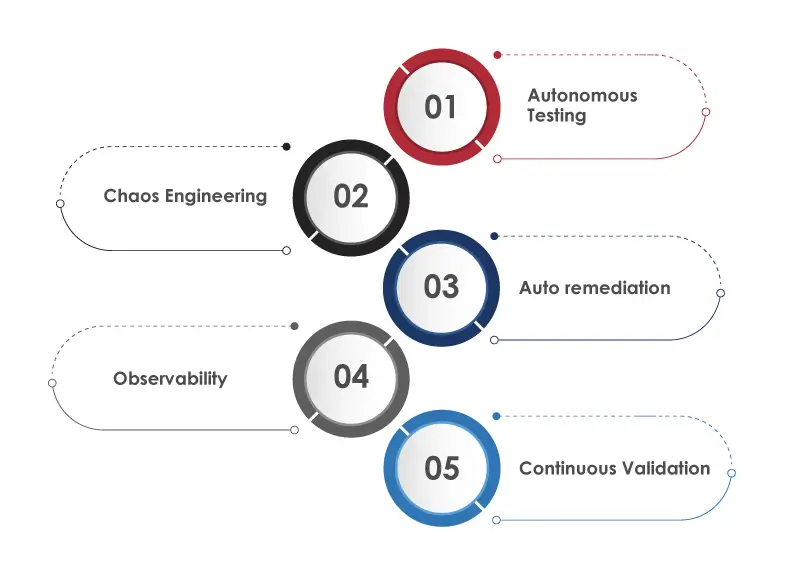- What is QA Reporting?
- Why and When do Businesses Require QA Reports?
- 5 Things to Include in QA Reporting
- Consequences of Inadequate QA Reporting
- How to Build an Effective QA Report?
- Why Partner with Tx for Comprehensive Testing?
- Summary
Businesses often struggle with the output of their testing processes even though they thoroughly go through every QA stage. The primary cause for this is insufficient QA reporting and analytics. Since the global software testing market is projected to hit $109 billion by 2027, the need for robust QA practices is of the essence for businesses. However, without strong reporting and actionable items, it becomes difficult for QA teams to identify improvement areas, track quality metrics, and align their strategies with business goals.
The software QA process should be transparent, and timely reporting is critical for tracking product health and facilitating accurate decision-making and planning. A high-quality QA report would ensure that a project meets defined standards at every SDLC stage, enabling businesses to deliver reliable, high-performance products.
What is QA Reporting?

Software testing and quality assurance will be critical elements in a successful product launch as businesses shift to digital solutions. QA includes multiple components, from test plan development and execution to debugging and root cause analysis. Every step is crucial for building confidence in the final product. But what helps keep track of all these steps and project development progress? The answer is “QA Reporting.”
QA reporting is a detailed document of testing activities involved in software development and QA lifecycle. It consists of details regarding tests performed, output, number of defects identified, and a comprehensive analysis of all these factors. QA reports deliver a complete view of the software quality at a given time interval.
Why and When do Businesses Require QA Reports?

QA reports are essential for software development. They allow businesses to gain detailed insight into their product/service quality. These reports also help identify issues and areas for improvement to ensure compliance with industry standards. Let’s look at some of the scenarios where QA reporting is required:
Development Phase:
To track project progress against quality standards defined in the planning stage, thus facilitating early issues detection and remediation.
Pre-release Phase:
To inform stakeholders about the software product’s readiness, highlighting any underlying defects that require immediate action and assessing overall quality.
Post-release Phase:
Document issues arising in the production phase and their fixes while providing feedback for continuous improvement.
QA reports also assist with stakeholders’ expectations management by offering a realistic view of software quality. They also support better business decision-making with their data-driven insights regarding product development and release.
5 Things to Include in QA Reporting

A structured QA report consists of several elements providing a clear overview of testing processes and results. Here are five essential elements to include:
Project Stakeholders:
A QA report begins with a project summary covering the software version, development phase, and relevant background to set the context. It clearly defines the scope, objectives, and focus areas of testing. Key performance indicators (KPIs) like defect density and test coverage will help measure success. Resource allocation, including testing teams, tools, and constraints, will also be included. Lastly, highlighting risks, issues, and mitigation strategies will ensure transparency and better decision-making.
QA Objectives:
Clearly define test objectives and align them with project goals to measure success rate. This will include executed test cases with brief descriptions to showcase the testing scope. The entry and exit criteria will define the start and end of the QA phase. Documenting the test environment (hardware, software, and network configurations) will also support result reproducibility and issue diagnosis.
Test Approach:
Outline the test approach, detailing manual, automated, or hybrid testing methodologies. Also, specify the testing methodology used, whether Agile, Waterfall, or DevOps, as it structures the testing process. Additionally, listing the types of testing performed—such as functional, performance, security, and usability— will help with a comprehensive view of software quality.
QA Output:
A QA report will provide a clear breakdown of testing output. It will also list each test case’s result (pass, fail, or block). Defects will be documented with details on severity, status, and any noticeable patterns. Comparing actual results against key performance indicators (KPIs) will allow businesses to assess how well testing met their project goals.
Recommendations:
The QA report will highlight key takeaways from the testing process, such as insights on testing strategies, resource use, and collaboration. Any unexpected findings or new risks will be noted to improve future efforts. Recommendations will focus on software enhancements, process improvements, or timeline adjustments. A summary of overall quality will indicate readiness for the next phase, whether further development, release, or monitoring.
Consequences of Inadequate QA Reporting

• Lack of transparency in the quality assurance process will prevent teams from tracking the accountability of each testing phase. It would also complicate audits, give rise to compliance issues, and reduce accountability.
• Not having clear visibility across improvement areas will cause inefficient resource allocation, while the team might focus on low-priority issues and neglect high-risk modules.
• Identifying patterns, defects, root causes, and areas that require urgent action will become challenging. This will lead to repeated mistakes as teams cannot learn from previous mistakes.
• Stakeholders will lose confidence in testing if QA reports do not deliver valuable insights or contribute to the project’s success.
• Consistent project delivery delays, increased defects, and inefficient QA practices will increase development costs.
How to Build an Effective QA Report?

Businesses should focus on actionable steps to optimize their testing process. This will be possible by following the below-given recommendations:
Create a QA Report Outline:
Start by drafting a clear outline that structurally guides the readers through the QA process, outcomes, and conclusion. This will ensure that no detail is ignored and that the flow is smooth between sections.
Use Easy-to-Understand Language:
Multiple stakeholders with technical and non-technical backgrounds will read the QA report. So, the language must be user-friendly and easy to understand, giving a clear picture to all. Avoid using technical jargon; otherwise, provide a detailed explanation if necessary.
Use Visuals for Clarity:
Insert visuals like screenshots, graphs, and flowcharts to make complex information more engaging and easy to understand. For example, screenshots can show specific issues or test results, while graphs show defect trends to showcase software quality improvement.
Why Partner with Tx for Comprehensive Testing?

QA reporting is a critical component in the software development and QA process. It offers clear, data-driven insights that influence stakeholders’ business decisions. Teams can assess software readiness, upscale QA efforts, and streamline product release cycles. At Tx, we follow a robust QA reporting framework that provides real-time dashboards, actionable items, and defect details. It enables our clients to improve their software quality and mitigate risks. Here’s what Tx offers:
Global Expertise:
Our skilled QA professionals and a strong presence across multiple geographies bring in-depth industry knowledge to deliver seamless testing solutions.
AI-driven Testing and Reporting:
Our AI-powered test automation, intelligent dashboards, and predictive analytics assist with software quality enhancement and issue resolution.
Test Automation Expertise:
Our end-to-end test automation solutions help reduce QA TCO by 40-50%.
E2E Testing Solutions:
We cover all QA needs, from functional to automation testing to performance and security checks.
Summary
QA reporting ensures software quality by providing real-time insights and aligning testing strategies with business objectives. It assists businesses in identifying issues, optimizing resources, and improving decision-making. Tx offers AI-driven reporting and industry-leading digital assurance solutions to enhance your software product reliability. Organizations can streamline testing, accelerate releases, and deliver high-quality digital experiences with Tx’s robust QA frameworks. To learn how Tx can assist you, contact our experts now.
The post How Does Effective QA Reporting Drive Business ROI and Growth first appeared on TestingXperts.
Source: Read More



